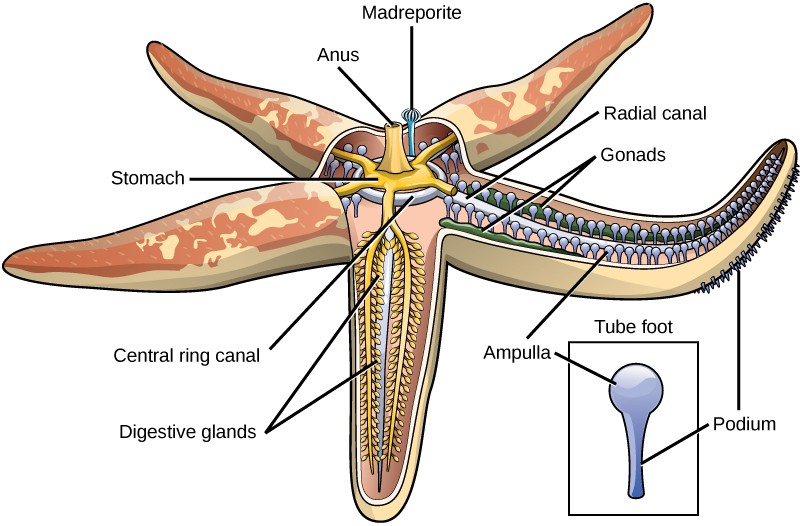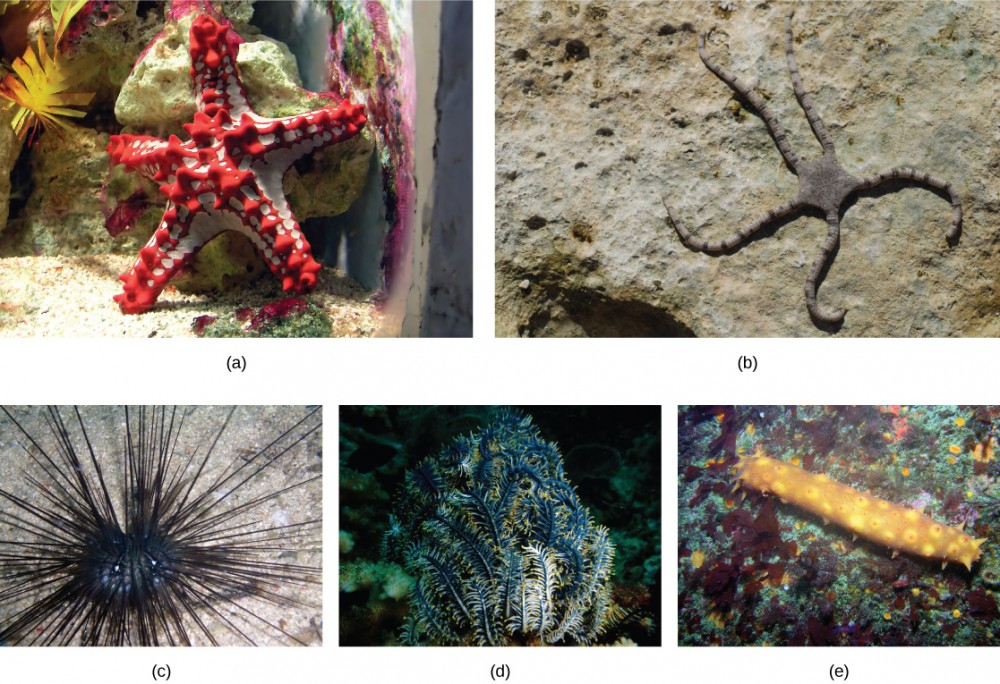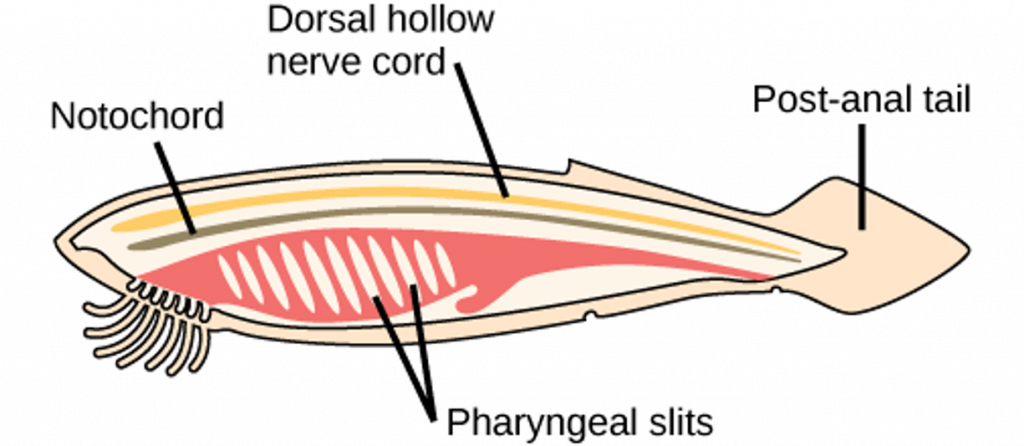9.5 Echinoderms and Chordates
Learning Objectives
By the end of this section, you will be able to:
- Describe the distinguishing characteristics of echinoderms
- Describe the distinguishing characteristics of chordates
Deuterostomes include the phyla Echinodermata and Chordata (which includes the vertebrates) and two smaller phyla. Deuterostomes share similar patterns of early development.
Echinoderms
Echinodermata are named for their spiny skin (from the Greek “echinos” meaning “spiny” and “dermos” meaning “skin”). The phylum includes about 7,0001 described living species, such as sea stars, sea cucumbers, sea urchins, sand dollars, and brittle stars. Echinodermata are exclusively marine.
Adult echinoderms exhibit pentaradial symmetry and have a calcareous endoskeleton made of ossicles, although the early larval stages of all echinoderms have bilateral symmetry. The endoskeleton is developed by epidermal cells, which may also possess pigment cells, giving vivid colors to these animals, as well as cells laden with toxins. These animals have a true coelom, a portion of which is modified into a unique circulatory system called a water vascular system. An interesting feature of these animals is their power to regenerate, even when over 75 percent of their body mass is lost.
Physiological Processes of Echinoderms
Echinoderms have a unique system for gas exchange, nutrient circulation, and locomotion called the water vascular system. The system consists of a central ring canal and radial canals extending along each arm. Water circulates through these structures allowing for gas, nutrient, and waste exchange. A structure on top of the body, called the madreporite, regulates the amount of water in the water vascular system. “Tube feet,” which protrude through openings in the endoskeleton, may be expanded or contracted using the hydrostatic pressure in the system. The system allows for slow movement, but a great deal of power, as witnessed when the tube feet latch on to opposite halves of a bivalve mollusk, like a clam, and slowly, but surely pull the shells apart, exposing the flesh within.

The echinoderm nervous system has a nerve ring at the center and five radial nerves extending outward along the arms. There is no centralized nervous control. Echinoderms have separate sexes and release their gametes into the water where fertilization takes place. Echinoderms may also reproduce asexually through regeneration from body parts.
Echinoderm Diversity
This phylum is divided into five classes: Asteroidea (sea stars), Ophiuroidea (brittle stars), Echinoidea (sea urchins and sand dollars), Crinoidea (sea lilies or feather stars), and Holothuroidea (sea cucumbers).
Perhaps the best-known echinoderms are members of the class Asteroidea, or sea stars. They come in a large variety of shapes, colors, and sizes, with more than 1,800 species known. The characteristics of sea stars that set them apart from other echinoderm classes include thick arms that extend from a central disk where organs penetrate into the arms. Sea stars use their tube feet not only for gripping surfaces but also for grasping prey. Sea stars have two stomachs, one of which they can evert through their mouths to secrete digestive juices into or onto prey before ingestion. This process can essentially liquefy the prey and make digestion easier.
Concept in Action

View this video to explore a sea star’s body plan up close, watch one move across the sea floor, and see it devour a mussel.

Brittle stars have long, thin arms that do not contain any organs. Sea urchins and sand dollars do not have arms but are hemispherical or flattened with five rows of tube feet, which help them in slow movement. Sea lilies and feather stars are stalked suspension feeders. Sea cucumbers are soft-bodied and elongate with five rows of tube feet and a series of tube feet around the mouth that are modified into tentacles used in feeding.
Chordates
The majority of species in the phylum Chordata are found in the subphylum Vertebrata, which include many species with which we are familiar. The vertebrates contain more than 60,000 described species, divided into major groupings of the lampreys, fishes, amphibians, reptiles, birds, and mammals.
Animals in the phylum Chordata share four key features that appear at some stage of their development: a notochord, a dorsal hollow nerve cord, pharyngeal slits, and a post-anal tail. In certain groups, some of these traits are present only during embryonic development.
The chordates are named for the notochord, which is a flexible, rod-shaped structure that is found in the embryonic stage of all chordates and in the adult stage of some chordate species. It is located between the digestive tube and the nerve cord, and provides skeletal support through the length of the body. In some chordates, the notochord acts as the primary axial support of the body throughout the animal’s lifetime. In vertebrates, the notochord is present during embryonic development, at which time it induces the development of the neural tube and serves as a support for the developing embryonic body. The notochord, however, is not found in the postnatal stage of vertebrates; at this point, it has been replaced by the vertebral column (the spine).
The dorsal hollow nerve cord is derived from ectoderm that sinks below the surface of the skin and rolls into a hollow tube during development. In chordates, it is located dorsally to the notochord. In contrast, other animal phyla possess solid nerve cords that are located either ventrally or laterally. The nerve cord found in most chordate embryos develops into the brain and spinal cord, which compose the central nervous system.
Pharyngeal slits are openings in the pharynx, the region just posterior to the mouth, that extend to the outside environment. In organisms that live in aquatic environments, pharyngeal slits allow for the exit of water that enters the mouth during feeding. Some invertebrate chordates use the pharyngeal slits to filter food from the water that enters the mouth. In fishes, the pharyngeal slits are modified into gill supports, and in jawed fishes, jaw supports. In tetrapods, the slits are further modified into components of the ear and tonsils, since there is no longer any need for gill supports in these air-breathing animals. Tetrapod means “four-footed,” and this group includes amphibians, reptiles, birds, and mammals. (Birds are considered tetrapods because they evolved from tetrapod ancestors.)
The post-anal tail is a posterior elongation of the body extending beyond the anus. The tail contains skeletal elements and muscles, which provide a source of locomotion in aquatic species, such as fishes. In some terrestrial vertebrates, the tail may also function in balance, locomotion, courting, and signaling when danger is near. In many species, the tail is absent or reduced; for example, in apes, including humans, it is present in the embryo, but reduced in size and nonfunctional in adults.
Visual Connection

Which of the following statements about common features of chordates is true?
- The dorsal hollow nerve cord is part of the chordate central nervous system.
- In vertebrate fishes, the pharyngeal slits become the gills.
- Humans are not chordates because humans do not have a tail.
- Vertebrates do not have a notochord at any point in their development; instead, they have a vertebral column.
(Answer: 1)
Invertebrate Chordates
In addition to the vertebrates, the phylum Chordata contains two clades of invertebrates: Urochordata (tunicates) and Cephalochordata (lancelets). Members of these groups possess the four distinctive features of chordates at some point during their development.
The tunicates are also called sea squirts. The name tunicate derives from the cellulose-like carbohydrate material, called the tunic, which covers the outer body. Although tunicates are classified as chordates, the adult forms are much modified in body plan and do not have a notochord, a dorsal hollow nerve cord, or a post-anal tail, although they do have pharyngeal slits. The larval form possesses all four structures. Most tunicates are hermaphrodites. Tunicate larvae hatch from eggs inside the adult tunicate’s body. After hatching, a tunicate larva swims for a few days until it finds a suitable surface on which it can attach, usually in a dark or shaded location. It then attaches by the head to the substrate and undergoes metamorphosis into the adult form, at which point the notochord, nerve cord, and tail disappear.

Most tunicates live a sessile existence in shallow ocean waters and are suspension feeders. The primary foods of tunicates are plankton and detritus. Seawater enters the tunicate’s body through its incurrent siphon. Suspended material is filtered out of this water by a mucus net (pharyngeal slits) and is passed into the intestine through the action of cilia. The anus empties into the excurrent siphon, which expels wastes and water.
Lancelets possess a notochord, dorsal hollow nerve cord, pharyngeal slits, and a post-anal tail in the adult stage. The notochord extends into the head, which gives the subphylum its name (Cephalochordata). Extinct fossils of this subphylum date to the middle of the Cambrian period (540–488 mya).The living forms, the lancelets, are named for their blade-like shape. Lancelets are only a few centimeters long and are usually found buried in sand at the bottom of warm temperate and tropical seas. Like tunicates, they are suspension feeders.

Glossary
- Cephalochordata: a chordate clade whose members possess a notochord, dorsal hollow nerve cord, pharyngeal slits, and a post-anal tail in the adult stage
- Chordata: a phylum of animals distinguished by their possession of a notochord, a dorsal hollow nerve cord, pharyngeal slits, and a post-anal tail at some point during their development
- dorsal hollow nerve cord: a hollow, tubular structure derived from ectoderm, which is located dorsal to the notochord in chordates
- Echinodermata: a phylum of deuterostomes with spiny skin; exclusively marine organisms
- lancelet: a member of Cephalochordata; named for its blade-like shape
- madreporite: a pore for regulating entry and exit of water into the water vascular system
- notochord: a flexible, rod-shaped structure that is found in the embryonic stage of all chordates and in the adult stage of some chordates
- pharyngeal slit: an opening in the pharynx
- post–anal tail: a muscular, posterior elongation of the body extending beyond the anus in chordates
- tetrapod: a four limbed animal; includes amphibians, reptiles, birds, and mammals
- tunicate: a sessile chordate that is a member of Urochordata
- Urochordata: the clade composed of the tunicates
- vertebral column: a series of separate bones that surround the spinal cord in vertebrates
- water vascular system: a system in echinoderms in which water is the circulatory fluid
References
Biology and the Citizen (2023) Copyright © 2022 by Utah State University is licensed under a Creative Commons Attribution 4.0 International License, except where otherwise noted.
Footnotes
- 1 “Number of Living Species in Australia and the World,” A.D. Chapman, Australia Biodiversity Information Services, last modified August 26, 2010, http://www.environment.gov.au/biodiversity/abrs/publications/other/species-numbers/2009/03-exec-summary.html.

